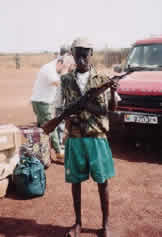|
 In June 1998, as a result of inner conflicts in the government, an armed
struggle began between the President, Nino Vieira, supported by troops from
Senegal and Guinea Conakry, and the chief of General Staff Ansumane Man�,
supported by 80% of the national army and a good part of the population.
The outcome of the conflict was dramatic: hundreds of civilians killed and
more than 100,000 refugees. In the June 1999, after the withdrawal of the
Senegalese and Guinean army of Conakry, the troops of General Man� defeated
troops loyal to President Vieira, who was forced into exile. At the end of
1999, the process of democratic development of the country began, with
political (December 1999) and presidential elections (January 2000). This
was shaken by another coup d'�tat attempt at the end of 2000. In June 1998, as a result of inner conflicts in the government, an armed
struggle began between the President, Nino Vieira, supported by troops from
Senegal and Guinea Conakry, and the chief of General Staff Ansumane Man�,
supported by 80% of the national army and a good part of the population.
The outcome of the conflict was dramatic: hundreds of civilians killed and
more than 100,000 refugees. In the June 1999, after the withdrawal of the
Senegalese and Guinean army of Conakry, the troops of General Man� defeated
troops loyal to President Vieira, who was forced into exile. At the end of
1999, the process of democratic development of the country began, with
political (December 1999) and presidential elections (January 2000). This
was shaken by another coup d'�tat attempt at the end of 2000.
 After the civil war, the situation of the country has deteriorated: a large
part of the capital has been destroyed or seriously damaged, the telephone
lines are largely inactive, a harvest year has been lost, the central
hospital, that was bombed extensively, is out of action. Also, the "Raoul
Follerau - Community of Sant' Egidio" hospital was bombed and occupied by
soldiers. The structure was seriously damaged and destroyed in many places,
as can be seen from the images. After the civil war, the situation of the country has deteriorated: a large
part of the capital has been destroyed or seriously damaged, the telephone
lines are largely inactive, a harvest year has been lost, the central
hospital, that was bombed extensively, is out of action. Also, the "Raoul
Follerau - Community of Sant' Egidio" hospital was bombed and occupied by
soldiers. The structure was seriously damaged and destroyed in many places,
as can be seen from the images.
 The social and sanitary situation is therefore particularly difficult,
because of the destruction of all structures, which were already lacking
before the civil war. Connections with neighbouring countries are also
problematic: the airport only operates during the day, the rail network is
insufficient, and the port is partially damaged. The social and sanitary situation is therefore particularly difficult,
because of the destruction of all structures, which were already lacking
before the civil war. Connections with neighbouring countries are also
problematic: the airport only operates during the day, the rail network is
insufficient, and the port is partially damaged.
|

